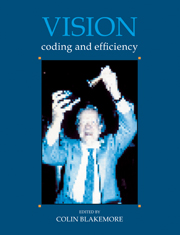Book contents
- Frontmatter
- Contents
- List of Contributors
- Preface
- Reply
- Acknowledgements
- Concepts of coding and efficiency
- Efficiency of the visual pathway
- Colour
- Brightness, adaptation and contrast
- Development of vision
- 19 On reformation of visual projection: cellular and molecular aspects
- 20 Retinal pathways and the developmental basis of binocular vision
- 21 Development of visual callosal connections
- 22 Sensitive periods in visual development: insights gained from studies of recovery of visual function in cats following early monocular deprivation or cortical lesions
- 23 The developmental course of cortical processing streams in the human infant
- 24 Maturation of mechanisms for efficient spatial vision
- 25 The puzzle of amblyopia
- Depth and texture
- Motion
- From image to object
- Index
19 - On reformation of visual projection: cellular and molecular aspects
Published online by Cambridge University Press: 05 May 2010
- Frontmatter
- Contents
- List of Contributors
- Preface
- Reply
- Acknowledgements
- Concepts of coding and efficiency
- Efficiency of the visual pathway
- Colour
- Brightness, adaptation and contrast
- Development of vision
- 19 On reformation of visual projection: cellular and molecular aspects
- 20 Retinal pathways and the developmental basis of binocular vision
- 21 Development of visual callosal connections
- 22 Sensitive periods in visual development: insights gained from studies of recovery of visual function in cats following early monocular deprivation or cortical lesions
- 23 The developmental course of cortical processing streams in the human infant
- 24 Maturation of mechanisms for efficient spatial vision
- 25 The puzzle of amblyopia
- Depth and texture
- Motion
- From image to object
- Index
Summary
Background
Development of the visual projection
The neural connections between the retinal ganglion cells and the higher order visual neurons in the midbrain (e.g. the optic tectum) or in the forebrain (e.g. lateral geniculate nucleus) develop in coherent topographic patterns. To establish the visual projections, individual ganglion cells send out their axons (the optic fibers) which grow towards the optic disc near the centre of the retina. The axons of ganglion cells exit the eyeball at its posterior pole and form a thick ensheathed bundle, the optic nerve. The growing tips of these axons select particular routes to reach their appropriate target zones along the visual pathways and eventually form synapses with higher order visual neurons.
Since the complexities of the visual pathways vary from one species to another we will discuss here a relatively simple example of visual projections in the goldfish. The optic fibers of goldfish make a complete cross at the optic chiasm and invade only the contralateral lobe of the optic tectum in the midbrain. Before they enter the rostral pole of the tectum the ingrowing axons from the ventral retina segregate from those originating from the dorsal area of the retina. The former select the medial branch of the optic tract and the latter the lateral branch. The optic fibers within the tectal tissue course through a superficial layer (the stratum opticum) towards the caudal pole along the spheroidal circumferences of the optic tectum. Most growing tips of retinal ganglion cell axons terminate in the subjacent layer (the stratum fibrosum et griseum superficiale) and form synapses with visual neurons of the tectum.
- Type
- Chapter
- Information
- VisionCoding and Efficiency, pp. 197 - 208Publisher: Cambridge University PressPrint publication year: 1991



